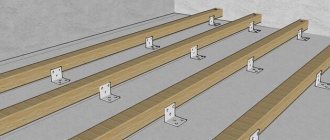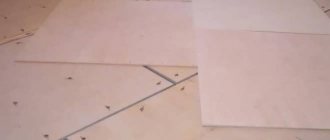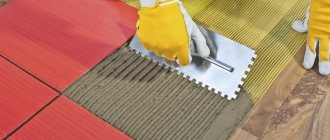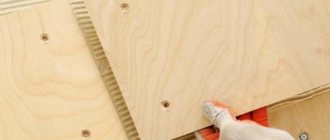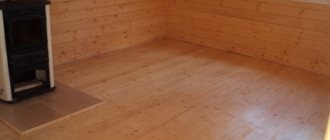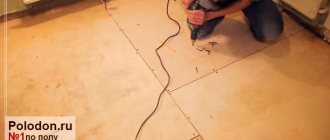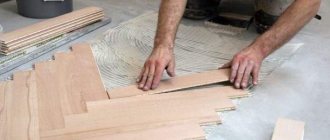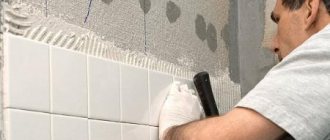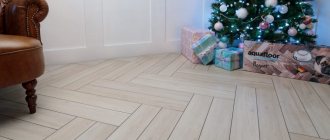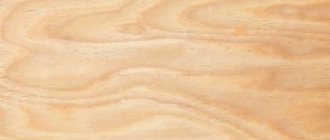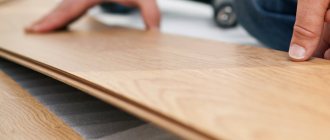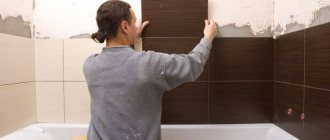Material such as plywood is increasingly being used to cover floors. However, if we are talking about wooden flooring, then laying plywood on a wooden floor is not so easy; there are certain nuances that need to be taken into account.
First of all, you need to understand what plywood is. This is a material consisting of 3 layers of wood, but it often happens that there are more such layers. There are several types of such material, so if the question arises about what kind of plywood to lay on the floor, it is recommended to opt for a waterproof option, which is impregnated with a special adhesive solution.
Plywood is great for subfloors because it is durable and does not warp.
Covering a wooden floor with such material is a very good solution, as it has a number of advantages.
First of all, it should be noted that plywood is the most practical subfloor for a living space. When such a floor is in use, it cannot be deformed, since there is no doubt about the strength and reliability of such a coating. This material can be used not only as a rough coating, but also as a base one.
But you should know that before laying plywood on a wooden floor, there must be a certain gap between its sheets, which does not have the best effect on the appearance of the floor. To avoid this, the plywood laid on the floor must be sanded (for this it is recommended to use fine-grained sandpaper), then everything is varnished and the result is a very attractive and prestigious appearance. For all this you need to use the following tools:
- Hammer. Nails. Self-tapping screws. Screwdriver. Building level. Hacksaw.
Plywood comes in 1-4 grades.
Using moisture-resistant plywood will allow you not to fear the consequences of a flood, which can always be caused by neighbors above. If we talk about the advantages of such a material, we should note its excellent thermal insulation qualities, which allow it to retain heat 20% more than other materials.
Laying plywood on a wooden floor is especially recommended in cases where it has completely become unusable (either dried out or loosened).
Using this material, you can put everything in order very quickly and inexpensively, and it will be very reliable. But if there are significant temperature changes in the room, then it is best to avoid using plywood; the same applies to apartments where there is high humidity. That is, there is no need to lay plywood in the bathroom or in a room where there is no heating.
Preparing Worn Wood Floors
Laying plywood on a wooden floor is carried out after inspecting and repairing the old covering:
- Remove the baseboards.
- Rotten floor fragments are replaced with new ones.
- Creaking and sagging floorboards are strengthened by screwing them to the beams with self-tapping screws.
- Areas with damaged paintwork are treated with an antifungal compound (primer).
- Check the plane with a level to identify differences and irregularities.
If the differences are significant, then leveling is indispensable. Most often, plywood is used for this purpose on a wooden floor - this material is the most popular due to its availability, cost and ease of working with it.
Minor irregularities and protrusions (2 - 4 mm) can be eliminated with a plane and/or a sander - in this case, the decorative coating can be laid directly on the wooden floor.
Stage 5. Format the sheets
Standard plywood sheets, as a rule, have dimensions of 125x125 cm. Here is an example of their installation:
However, many experienced craftsmen consider it necessary to cut them into four more parts to get squares with a side of 60 cm
These are not only more convenient to work with, but they end up with much more damping joints at the joints, and this is important for compensating for moisture and thermal deformations. And the sheets themselves will be much stronger, because they are now less susceptible to deformation
But after cutting the plywood, it is important to pay attention to the ends of the workpieces - there should be no delamination in them. If there are any, then just change them, the floor will turn out to be of poor quality
If you lay plywood in two layers, then divide the future thickness of the flooring by two:
Keep the plywood sheets for several days in the room where you will lay them. Just lay them on top of each other to avoid deformation; even better, place them on edge if the sheets themselves are not too thin. This is necessary to acclimatize the sheets, but if you make a plywood floor right away, without such preparation, then the laminate laid on top will go in “waves”: the sheets will simply pick up moisture from the air, like everything that is in such a room, and this will happen natural expansion. The plywood base will swell and the laminate will begin to lift in places, breaking the fragile locks. Needless to say, the finishing coating itself will not last long under such circumstances either.
And it is also important how different the humidity and temperature were in the warehouse. So, if the difference is small or the conditions are the same, it is enough to leave the plywood in the room overnight; if the difference is from 2 to 8 degrees, it’s about three days, and if it’s larger, it’s a whole week.
What kind of plywood is used for the floor
Plywood is available in various thicknesses, sanding and finishing qualities. Therefore, an inexperienced builder is always faced with the question: what kind of plywood to lay on a wooden floor so that it will be a reliable basis for a decorative coating.
- The brand of plywood is a difficult choice for the home craftsman. Usually the choice is made between the FS and FSF brands. FC is plywood in which the veneer sheets are glued with a less toxic glue than the FSF brand (read: “Which plywood is better for the floor - choose the brand and type of material”). However, the quality characteristics of FC are weaker: it is not very moisture resistant. Therefore, if environmental friendliness and safety are a priority (floors in a children's room, bedroom), then it is better to buy FC. For rooms with high humidity and traffic (the hallway of an apartment, a country house), FSF is chosen.
Note: there are brands of plywood that combine strength, moisture resistance and safety (for example, FB), but due to the high cost (2 - 3 times compared to FC), the average user rarely considers this option.
- The quality of the material also matters: the higher the grade of plywood, the better, smoother the surface, which means the decorative coating will fit better and last longer. To level the floors, grade 1 and 2 plywood is used.
- Plywood can be sanded on both sides (Sh2), on one side (Sh1), and not sanded (NS). For leveling take Ш1.
- Material thickness. Experts believe that for floor work this material should be at least 8 mm thick, and preferably more (for more details: “What thickness of plywood is suitable for a floor”). What thickness of plywood to lay on a wooden floor is regulated by a simple rule: the thicker, the better. At a minimum, the plywood should not be thinner than the final floor covering.
Sometimes plywood is used as a subfloor, laying sheets directly on the joists. In this case, the thickness is needed from 2 cm.
Plywood: advantages and disadvantages of the material
Pressed sheets are an excellent material for rough and primary work. They are inexpensive, easy to transport, easy to install and are good at eliminating small differences in floor level. Often they prefer to lay linoleum, parquet boards or laminate on plywood, since it has the following advantages:
- laying sheets significantly reduces the time of preparatory work before installing the final finishing floor covering;
- prevents rotting of the underside of floor coverings due to good ventilation between the material and the concrete screed;
- a floor lined with plywood prevents premature wear or deformation of linoleum or carpet, extending the life of the decorative coating;
- provides a smooth subfloor;
- plywood sheets are light, hard, durable, resistant to stress and abrasion;
- plywood is flexible enough and does not break during installation;
- has no pungent odor;
- has good sound and heat insulation properties;
- due to the large size of the sheets, the number of joints is minimal;
- high-quality factory grinding prevents slipping of the sheet and materials placed on it.
Characteristics of plywood
Do you need any preparation for plywood?
Covering the floor with plywood on a wooden floor begins after preparing the plywood sheets. They need to be brought into the room where installation is planned and left for 2 - 3 days. Wood tends to change dimensions depending on humidity and temperature, so it is necessary that these parameters of the material and the environment coincide.
Experts advise moistening the edges of plywood sheets with water at room temperature if the room in which work is being done is not heated regularly.
It is also advisable to treat the sheets with an antifungal and fire-retardant primer.
Attention: you should not work with plywood in a room with high humidity: if condensation accumulates on a piece of film left in the room during the day, it is recommended to dry the room using available means (heating devices, turning on the heating).
Peculiarities
To choose plywood for leveling the floor, you need to understand the features and classification of the material on the market. Plywood varies in grade, thickness, moisture resistance and material of manufacture.
There are 4 types of plywood that can be distinguished visually:
- The fourth grade has defects on the surface, rough, there are holes from knots, since the lowest quality raw materials are used for production.
- The third grade is of better quality than the previous one and there is less defect on the surface.
- The second grade has minor cracks and is smooth.
- The highest quality and most expensive first grade is well polished, all sides are without defects.
When choosing a variety, they are guided by price and quality. For the construction of a subfloor, plywood of the second and third grades is suitable. According to the processing method, they are distinguished:
- Unsanded plywood.
- Sanded (one or both sides).
Plywood is made from deciduous and coniferous wood (usually pine and birch). Wood veneer is bonded together using natural and synthetic resins. The top layer can be treated with a varnished water-repellent composition.
Based on resistance to moisture in residential premises, the following brands are distinguished:
- FBA.
- FSF.
- FC.
In bedrooms and other living rooms with low humidity, FK and FBA brands are laid, made on the basis of urea and albumin casein glue. They are environmentally friendly and have average resistance to moisture.
The thickness of the canvas is determined by the number of layers of veneer. An odd number of them are laid perpendicular to the previous one, creating a durable building material. For laying the subfloor, use plywood with a thickness of 10 mm and above.
An analogue of plywood in the construction market is OSB - oriented strand board. Such materials have similar properties, but differ only in production. For plywood, the raw material is wood veneer, and for OSB, wood chips are processed with natural resins.
OSB is divided into different categories:
- The first one is suitable for minimal load and dryness.
- The second is produced for low-traffic residential premises.
- The third is characterized by high moisture resistance and strength.
- The fourth is used in the construction of walls.
- Varnished or laminated – covered with a protective layer of varnish or laminate.
- Tongue-and-groove - has a connecting groove at the joints.
The best solution for the subfloor would be OSB 3, tongue-and-groove and easy to install. Such sheets are produced with a thickness from 0.5 cm to 4 cm.
Measure seven times: cutting and fitting sheets
Cut sheets of the same shape. Experts recommend 0.6 by 0.6 m, but you can do 1 by 1 m or 1 by 0.5 m - it all depends on the thickness of the plywood and ease of use. After cutting, the sheets are tried on: laid on the floor, following the “staggered” method - the transverse joints should not match, the appearance of the laid sheets resembles brickwork (read: “How to lay plywood on the floor - laying rules”). You should ensure that the damping distance is maintained during installation: a gap of 2 - 3 cm from the wall, 0.5 - 1 cm between sheets. If the fitting was successful, the sheets are numbered so that the final attachment of the plywood to the wooden floor goes smoothly, without a frantic search for the right sheet. In addition, it is useful to draw a plan for laying sheets with the corresponding numbering. Finally, you should mark the floor with a pencil or chalk so that you know where to place the joists.
Note: cut plywood is inspected for defects formed during cutting; delaminated or deformed ends of the sheets will affect the quality of the coating; it is better to replace them.
Preparing the base according to the first option
In any log house, the floors are laid on logs: wooden beams laid at the stage of erecting the first crown of walls.
- Subsequently, a rough floor is placed on these supports. Substandard boards are used for it.
- When installing thermal insulation, slats are placed on the first layer of the base in increments of 40-50 cm (based on the dimensions of the insulation).
- This structure is covered with a waterproofing sheet without tension.
- In the spaces between the slats, mats (rolls) of mineral or basalt wool are placed loosely. In some cases, bulk materials are used, for example, expanded clay. It serves as excellent sound insulation.
- A vapor barrier material is placed on top of the constructed structure and lightly pinned to the slats.
After this, plywood is laid down to finally level the floors. This base for laminate flooring is durable and reliable, and has additional comfort conditions.
Tools for making a plywood base
Before starting work, you should check that you have the necessary set of tools:
- Electric jigsaw;
- Drill with a set of drills;
- Screwdriver;
- Level;
- Roulette;
- Self-tapping screws;
- Dowels.
After installing the plywood base, you will need to prepare it for decorative flooring: thin coverings (linoleum, carpet) will require careful sanding of the surface. To do this, it is better to purchase a grinder or use a special attachment for a drill. You can use fine-grit sandpaper if the floor area is small.
Table of screw sizes for plywood, furniture board, fiberboard, chipboard, MDF, OSB
Taking into account the peculiarities of the operation of wood-based materials, a table is presented below that allows you to select the required self-tapping screw size.
When choosing self-tapping screws for Plywood, OSB, chipboard, you should take into account that the dimensions of the board of finishing material may vary depending on the humidity of the environment, therefore the most loaded points of fastening of wood-based board materials are the points located along the perimeter of the board.
The number of attachment points (the number of screws) is determined by the size and thickness of the slab and in most cases is at least 20 per square meter, provided that the screw size is selected correctly. In the middle of the slab, a lower density of fastening points is allowed than along the perimeter.
Plywood leveling technology
Before laying plywood on a wooden floor, a technology of execution is chosen; the choice depends on the magnitude of the differences and unevenness of the wooden floor. Three alignment methods are used:
- Leveling by laying sheets directly on a wooden floor. It is used if the unevenness is no more than 1 cm and is formed by the ribs of the floorboards. The flatness of the sheet, based on the protruding edges, evens out the difference. This installation method often uses a plywood underlay on the wood floor to act as a shock absorber and improve thermal insulation.
- Leveling using point supports (bosses). Used as a budget option for floors with small differences. For the bosses, squares cut from plywood, laminate, or boards are used.
- The sheathing device for leveling floors is used when horizontal differences are 1–8 cm. The strip support is made from beams or cut strips of plywood; this method is the most expensive, but also the most reliable.
For any type of base, the rule is: the thinner the plywood, the closer the support points should be.
Floor unevenness
Plywood can compensate for any imperfections in the base. It successfully copes with small dents of the subfloor; it also successfully solves the problem of excessive slope, the presence of surface differences, and a concave or curved floor plane.
For large differences in height, a subsystem of wooden blocks is used to level the floor plane to the required parameters; on bases with minor flaws, a layer of plywood is simply laid on the floor and serves as a leveling coating.
All options require the correct selection of material that can perform its functions in the required mode, not sag during movement and not create noise.
The procedure for leveling using joists
Before starting leveling, determine the highest point of the floor by level. From this point they begin laying lags - beams located in parallel. Lay the logs, adhering to the marks made during the initial layout of the plywood fragments. They need to be located at the junction of the sheets.
- The logs are laid one by one and secured to the wooden floor using special glue and self-tapping screws. Each beam is checked with a level in all directions, if necessary, placing bosses under it and filling irregularities with plywood trim. Pieces of trim should be additionally lubricated with glue to increase the reliability of the base. There is a special glue for plywood on wooden floors that does not require additional fastening. But more often, craftsmen use proven methods: they lubricate the required places with available glue (“Bustilat”, “Liquid Nails”, “Moment”), and then secure them with self-tapping screws.
- Then the sheathing is installed - transverse bars located at a distance equal to the width of the prepared sheets, and in accordance with the original marks. Installing a plywood sheathing on the floor will make the coating more stable and durable. It is necessary to carefully observe the markings so that the sheets, during the subsequent installation of plywood, do not, as they say, “hang in the air,” but are attached to the sheathing and form a reliable plywood floor in a wooden house or apartment.
- To improve heat and sound insulation, the sheathing space can be filled with appropriate material, after first getting rid of construction waste.
- Plywood sheets are fastened according to the diagram, checking the number marks. To ensure that the heads of the screws do not protrude above the plane, they are recessed. To do this, drill a recess at the attachment point equal to the diameter of the screw head.
After installation is completed, all that remains is to prepare the plywood floor in accordance with the type of finishing coating. For thin coatings, all irregularities, cracks at joints, and recesses from recessed screws are puttied. For more rigid coatings, a special noise-absorbing underlay may be needed. In any case, it is advisable to varnish the plywood several times to extend its service life.
Laying on the frame
Plywood floors on joists are formed using the following technology:
- Supporting parts are set with a fixation step of 40–60 cm. It is taken into account that all products must be placed in the same plane.
- The treated slabs must be laid in a checkerboard pattern so that the joints fall on the timber. To fasten the products, wood screws are used. A distance of 15–20 cm is formed between the screws.
- Before fixing the flooring, the logs must be treated with antiseptics and fire retardants.
For flooring in domestic premises, logs can be laid in increments of about half a meter, and for highly loaded rooms, logs are installed at a distance of 150 - 200 mm
Attention! With a distance between the support beams of up to 40 cm, the optimal sheet thickness is 12 mm, 60 cm - from 15 mm.
Rules you need to know
Before laying plywood on a wooden floor, it is worth checking and repairing all communications running under the floor, so that later you do not have to open up a new finished floor. It's worth knowing that:
- The length of the screws used in the work should be three times the thickness of the plywood.
- The distance between the screws is no more than 20 cm.
- The sheets are screwed, retreating 2 cm from the edge.
- If there is thin plywood, it is used in 2 layers, placing the sheets so that the seams of the top and bottom layers do not coincide.
- When installing a plywood base using the point method, the bosses are placed at a distance of 20–25 cm.
Photos of beautiful modern coatings will not leave anyone indifferent, and an insufficiently level floor will no longer be an obstacle. Using these recommendations, any man who knows how to hold a tool will know how to lay plywood on a wooden floor and will be able to do it with his own hands.
Technical nuances
Sometimes laying the floor with plywood on joists is the best solution. If wood is expensive in the region, it is cheaper to lay plywood directly on the joists - without a rough wooden floor. The height of the log depends on how much the finished floor level needs/can be raised. If the floor does not need to be raised to a significant height, you can save money and use a board with a thickness of 28 mm or more as a joist. If the floor needs to be raised to a greater height (from 50-60 mm), we take a beam of a suitable cross-section.
The minimum board thickness for joists under a plywood floor is 28 mm
If 50-60 cm is not enough, a small “shortage” (5-8 cm) can be “added” using spacers - cuttings of timber of the required size. All the same, a perfectly level base is very rare, and spacers are used under the logs to bring them “to the horizon” (as in the photo above). If you need to raise the finished floor even higher, then take 150*50 mm timber (for example). If this height is not enough, a sheathing of edged boards is made on top (perpendicularly), achieving the desired height.
How to lay plywood on joists: with edged board sheathing
In any case, we use chamber-dried lumber, first or highest grade. They are usually coated with bacterial protection. It can also be impregnated with compounds that reduce flammability. Before laying, it is advisable to keep the wood indoors for a week. Then there will be a guarantee that the floor will not creak.
Chamber drying boards and timber are very expensive. To save money, you can buy regular lumber (but not raw) and keep it for about a year in a well-ventilated area (in an attic, in a shed) or in a stack outside, covered on top (but not hermetically sealed) from rain. But during the drying process, some of the material will crack, some will twist, etc. So the source material must be purchased with a reserve for rejection. The amount of the reserve depends on the initial state of the forest. The more raw lumber you use, the more waste there will be.
Lag pitch and plywood thickness
The lag laying step is calculated from the center of the beam or board. The beam width is at least 50 mm, the pitch is from 300 mm to 900 mm. The greater the distance between the supports, the thicker the flooring required. That is, the thickness of the plywood for the floor along the joists depends on the distance at which the joists are installed from each other. So when installing a plywood floor, there are options:
- Lay joists less often and use thicker plywood.
- Install the joists with a small gap, use a smaller thickness of the flooring.
Which is more profitable? You will have to count for each region. In some places the first option will be cheaper, in others the second. If you also need to raise the floor to a considerable height, you can get out of this situation by installing joists, nailing the sheathing across them across the battens, and then placing plywood sheets on them.
Table for choosing plywood thickness depending on the joist installation pitch
Laying plywood on a wooden floor under laminate, linoleum is included in the technological map. It is recommended to lay plywood under parquet and parquet boards. In this case, long-term operation of the finishing coating is guaranteed. So, covering the floor with plywood is a justified decision in many cases. It's just expensive. Currently there is cheaper sheet OSB. But plywood has a more stable quality, and with OSB - depending on your luck.
Plywood thickness for floor joists
The thickness of the plywood is selected depending on the selected floor design. The specific thickness depends on the distance between the lags:
- logs every 300 mm, plywood needed 9 mm;
- supports every 600 mm - sheet plywood is required no thinner than 12 mm;
- the logs are installed at 900 mm intervals - we put 18 mm plywood and no less.
Which plywood for the floor to choose?
Coniferous, birch or combined? Birch is better, but coniferous is optimal for the price. When laying on joists, two layers are usually laid. The total thickness should be no less than recommended. Two layers are done to get the most stable floor at minimal cost. Because the material for two layers of 12 mm will cost less than one layer of 21 mm. But when laying two layers of plywood, the installation time will increase and the consumption of fasteners will increase. This is also worth taking into account.
Thickness of plywood on old floor
When laying on any hard base (rough or old plank floor, concrete), one layer of plywood may be sufficient. Moreover, it is possible to level it in this way even on an uneven base. But in this case, two layers will be required and we take their total thickness from the table above. Due to its high degree of elasticity, such flooring can compensate for unevenness.
The thickness of plywood for floor boards is 10-12 mm
Provided there are no significant differences (only a few millimeters are acceptable), the thickness of plywood for laying on an old floor is 10-12 mm (in one layer). This will be more than enough even for coatings that require stability of the base.
How do you attach the joists to the base?
If the sheathing is attached to a concrete base, studs are used. In wood and concrete, a hole is pre-drilled with a drill whose diameter is 1.5-2 mm smaller than the fastener. The length of the fastener must be such that at least half the length of the stud/bolt enters the base.
How to attach joists under plywood to the base
If for leveling you use several shims made of materials of different thicknesses, then you need to drill the hole so that the pin/bolt catches them too. This is a guarantee that the gaskets will be secured and the floor will not sag or begin to creak.
Soundproofing and thermal insulation
In a multi-storey building, you should take care of soundproofing your floor - there will be fewer problems with your neighbors. To do this, it is better to use materials that do not conduct sounds well as leveling pads - rubber, fiberboard, pieces of linoleum. You can also install special vibration damping pads.
You can insulate a plywood floor with any of the materials
For thermal insulation, mineral wool is placed between the joists. In high-rise buildings (second floor and above) this is the best choice. The material dampens sounds and has good thermal insulation properties. Expanded clay should not be used as thermal insulation. Compared to modern materials, it is less effective (the characteristics are 4-7 times worse). You can use polystyrene foam or extruded polystyrene foam. But this choice may be justified if there is an unheated room below or the floor of the first floor in a private house. In this case, foam glass may have even better properties. 100% harmless, excellent thermal insulation characteristics, does not burn. But the price is high.
Please note that on the ground floor of a high-rise building or in a private house, waterproofing is spread over the joists. And it’s better if it’s a membrane rather than a film. The canvas is spread over the joists, the edges are placed on the walls, securing them there no lower than the level of the finished floor.
Laying plywood on the floor: rules
To prevent the plywood floor from sagging and playing underfoot, the first layer is laid so that the fibers of the outer veneer layer are perpendicular to the joists. In this case, the dimensions of the sheet and the pitch of the lag must be selected so that the joint of the sheets falls in the middle of the beam/board.
The junction of two sheets should be in the middle of the board or beam
If the lag pitch is large (50 cm or more), an additional beam is installed under the connection along the short side so that the joint does not hang in the air.
Rules for laying plywood on the floor
When laying out sheets, remember the following rules:
- A gap of 20-30 mm is left between the edge of the sheet and the wall. This way the plywood will not rest against the walls. When temperature and humidity change, it changes size. And this gap compensates for this expansion, otherwise warping will begin and the joints may rise.
- The sheets do not fit together tightly. Leave a gap of 3-5 mm. This is also to compensate for thermal and humidity expansion.
- The second layer is placed so that the seams do not coincide. This is necessary to ensure that cracks do not form in the floor. It also makes the floor more durable and stable.
With a large pitch, transverse bars are added on which the joints of the sheets will rest.
A few words about installing the fasteners. Lay out the plywood sheet and adjust it the way it should lie. Next, mark the position of the joist (middle) and jumpers on it - then it will be easier to install the fasteners.
Plywood fasteners
You can attach plywood to the joists with nails or self-tapping screws. Self-tapping screws are not hardened (they break less often). The length of the fastener is not less than three times the thickness of the sheet. That is, for fastening plywood with a thickness of 12 mm, a length of 35 mm or more is suitable. The fastener installation step when laying plywood is 15 cm.
When laying plywood, do not forget about the gaps
The second layer of plywood is often fixed with glue. They usually use construction PVA, but any type that can be used to glue wood is suitable. “For reliability” they also add screws. To get into the logs when attaching the sheets of the second layer, the position of the supports is marked not only on the plywood, but also on the walls. But, even if the fasteners only connect sheets, this will be enough.
The rules for laying the second layer are the same: compensation gaps are needed. And the seams should not coincide with the seams of the bottom layer. They must be offset by at least 30 cm.
Tools for work
To prepare and lay plywood you will need:
- Saw or jigsaw for cutting.
- Drill-driver - for screwing screws, drilling, countersinking work.
- A hammer drill is required for hard foundations (concrete, reinforced concrete, cement screeds).
- Spatula for applying glue.
- Hammer, screwdriver, pliers are auxiliary tools.
- For marking and control - a bubble level, a laser level or a spirit level (hydraulic level), a tape measure, a square, a carpenter's pencil.
Installation of logs under plywood
The logs are secured to the prepared linings using screws. The fastener must be recessed into the beam so that the head does not protrude on the surface. It will probably not be very aesthetically pleasing if the laid floor covering is damaged. In the photo and upon visual inspection, such a floor can no longer be called high-quality.
To increase the strength of the lag in the places where the pads are located, you can additionally fix the beam using a special wooden profile (crossbar), which will also be fixed to the pad, enhance the adhesion effect and increase the stability of the base.1
An alternative way to secure the joists does not require the use of spacers. In this case, the logs are also leveled with pieces of roofing material, and secured with long anchors or dowels, the length of which exceeds the thickness of the beam by 5-6 centimeters.
How to treat the surface → Room decoration → How to choose the right paint → Surface treatment technologies → Leveling and finishing the walls → Selecting and applying a primer → Removal from the surface → Stretch ceilings and technologies → Reviews and testimonials
Expert opinion
Strebizh Viktor Fedorovich, leading construction foreman
Glue with the addition of pine resin is best suited; it is often not indicated in the composition, but its presence can be determined by smell; this is, for example, Thomsit 200 or 400. If you want to clarify something, please contact me!
Installation on old floorboards
If you are not going to spend both energy and time on raising the floor level in the room or leveling the level of the joists, you can lay plywood directly on the old boards. The main thing is that the floorboards do not creak or sag.
The plywood squares should be laid with a slight offset, being careful not to cross the seams at one point.
After the flooring is ready, check if it is even. To do this, take a two-meter long strip and attach it to the surface, changing its position several times and pointing it in different directions. Also check the slope of the surface by using a level. According to standards, an acceptable deviation is considered to be 0.2%. It is also worth tapping each of the plywood squares with the end of a wooden block to reveal the delaminated parts. Defective ones will sound hollow and hollow, high-quality ones will sound loud.
Selection of material for work
The correct choice of plywood suitable for a particular case is the key to successful completion of the work and durability of the base. The first step is to decide which brand of material to choose. Plywood also has its own types and types, differing in strength, moisture resistance and quality.
Choosing plywood for the floor
Table. Grades of plywood depending on impregnation.
| Brand | Description |
FSF | In the manufacture of this type of material, phenol-formaldehyde glue is used. This plywood is quite wear-resistant, durable and strong, and has a good ability to resist moisture. Very often used for laying as a base for finishing flooring. It is also used in roofing work. There is also plywood of the FSF-TV brand; its properties are very similar to ordinary FSF, but it can withstand the effects of fire in a fire. Typically used in carriage building. |
FC | To manufacture this type, adhesives containing urea are used. This plywood is less resistant to water and is often used for interior decoration. Can also be used for installing subfloors. |
FBA | Albumin-casein glue is used as a connector material in this case. This is the most environmentally friendly type of plywood, but its moisture resistance is extremely low. |
FB | Bakelite varnish is the adhesive component in sheets of this type. Such plywood is not afraid of the external environment, is not afraid of water, and is even used in regions with a tropical climate. |
BS | The adhesive component is alcohol-soluble bakelite glue. Ultra-durable, water-resistant material. Flexible and resilient, not subject to rotting. Previously, such plywood was used only in aircraft and shipbuilding. |
BV | This plywood also contains bakelite glue, but it is water-soluble. According to its characteristics, it completely replicates BS plywood, except that it is afraid of water. |
In general, FSF and FK grade plywood is usually used to level the floor. These species have an optimal price-quality ratio with sufficient resistance to water.
Laminated plywood
Prices for laminated plywood
laminated plywood
Also, plywood can be divided into several types depending on the number of veneer layers - three-layer, five-layer, multi-layer. There is also four-layer plywood, but it is rare.
What is the standard thickness of plywood?
Comparison of plywood with other flooring materials
Depending on the type of surface treatment, plywood is divided into sanded NSh, sanded on one side Sh1 or on both sides Sh2. This type of material also has several grades depending on the quality of the fabric:
- elite plywood, the surface of which should not have any flaws;
- first grade, on the surface of which there may be minor roughness or microcracks;
- second grade, where surface defects can be up to 5% of the total sheet area, sometimes scratches and dents are allowed;
- third grade, where there are holes from knots and wormholes;
- fourth grade - sheets have a huge number of defects.
Plywood varieties
To create a rough base for a plywood floor, you can use sheets of the second or first grade. However, due to the high price of the latter, it is used extremely rarely. The third grade can also be used, but due to the large number of damages it is not recommended. The best option is FSF plywood, Ш1, 15 mm thick.
Sanded plywood
Step-by-step instruction
To install a prefabricated screed yourself, you will need:
- Sheets of plywood of suitable thickness.
- Wooden logs.
- Lining material for leveling the base.
- Antiseptic primer.
- Hardware.
- Soundproofing and/or thermal insulation with components.
- Repair compounds for partial restoration of damaged foundations.
- Waterproofing.
- Damper tape.
- Silicone sealant or elastic wood putty.
- Tape measure, marking pencil, metal ruler or lath.
- Drill/screwdriver or hammer/nail gun (nailer) with accessories.
- Laser or water level.
- Spatulas, brushes, rollers.
- Construction vacuum cleaner.
- Cutting tools with accessories for wood and plywood (circular saw, jigsaw, etc.).
- Grinder machine.
The technology for installing prefabricated screeds is partially presented in SNiP 3.04.01–87 (SP 71.13330.2017) “Insulating and finishing coatings.” In accordance with the recommendations of these standards, installation is carried out in 4 stages.
Preparation
Any repair begins with cleaning the base from debris, dirt and dust. It is advisable to remove oil, bitumen and similar stains, traces of soot and soot from the surface.
No professional will begin work without partially repairing the damaged areas. Rotten, damaged elements of the wooden flooring must be replaced, and cracks and loose areas of the mineral base must be restored. To do this, you need to open up the cracks, remove dust and fill with repair compounds. If possible, it is better to clean off fragile sections, and smooth out the resulting pits using cement-sand, self-leveling and other quick-drying mixtures.
If necessary, the floor is waterproofed. It is needed if:
- it is necessary to protect the structure from residual moisture of the concrete base;
- there is a cold basement under the ceiling;
- the floor on joists is installed in the bathroom and the room located on the floor below should be protected from possible leaks.
To create waterproofing, the entire available range of materials is used: films, membranes, rolled adhesive products, coating compounds, painting agents, and the like.
In some cases, soundproofing of the base is required. According to the rules, the acoustic layer is laid between the base floor and the screed. Therefore, sound-absorbing mats are laid under the logs. If sound-insulating mineral wool (stone or glass) is used, then it must be laid in the openings between the joists, and the support rails themselves must be fixed using point acoustic pads.
Laying logs on acoustic pads.
It is advisable at this stage to treat the timber, bosses and other wooden structural elements with antiseptic impregnations.
Formation of a power frame
The frame of logs can be formed in the form of longitudinally located beams or as a single or double sheathing. Of course, the second option creates more reliable support for the plywood.
SNiP 3.04.01–87 (SP 71.13330.2017) recommends laying slats across the light flow, and in corridors and other rooms with a certain direction of foot traffic - perpendicular to the movement. Of course, in the future the frame will not be visible under the coating, but the essence of the advice is different. The developers of the building code determined that if the frame is formed across the most intensive movement of people, then the loads will be distributed over the majority of the supports of the load-bearing frame, and not among 2-3 elements. Or even worse - between them.
First of all, the zero mark is identified, relative to which the supports are aligned. Next, the beacons are mounted under the joists or the required level is stamped on the wall with thread and dye. But the most convenient way to construct a reference line is a laser level with a plane builder.
If sound insulation is required, before installing the supporting frame, it is necessary to lay acoustic material on the base: slabs, membranes, rolled products.
Now you can begin installing the logs, observing all the necessary gaps:
- Between the outer batten and the wall - at least 20 mm.
- Between adjacent supports - from 30 cm, but not more than 50 cm. We remind you: the higher the load on the floor, the more frequent the logs should be.
- Between the ends of one row – 0–0.5 cm.
For leveling, gaskets made of chipboard, OSB, MDF, etc. are installed under the frame elements. After checking with a level, the bosses or backing boards are attached to the base of the dowel - with nails, screws or anchors.
Plywood linings.
Joists on wooden bosses.
To drill holes for hardware in underlay components, joists and plywood, you should purchase feather or special wood drills with a countersink.
Many craftsmen recommend laying damper layers on firmly fixed supports. Such a preventive measure will prevent the structure from starting to creak in the future.
The penultimate step is to fix the joists over the entire area of the room using suitable hardware. Please note that a wide strip should be laid in doorways, which will protrude beyond the partition by 50–100 mm on each side.
For maximum leveling accuracy, you can use fastening and supporting hardware designed for adjustable floors. Essentially, these are powerful anchors that are installed in the floor slab. The adjusting nuts are screwed onto the main bolts, then the beam is placed and secured with a lock nut. The excess anchor rod is cut off with a grinder or a metal file.
If you plan to insulate the floor, then under the frame, in accordance with the manufacturer’s recommendations, you need to lay a vapor barrier. But after installing the logs, a suitable thermal insulation material is placed in the resulting “windows”: mineral wool, expanded clay, ecowool, linen or synthetic mats.
Laying plywood boards
The most controversial issue is the thickness and number of layers of plywood. There is no single correct opinion. It is clear that the higher the expected load on the floor (weight of furniture, intensity of foot traffic, etc.), the greater the thickness of the slabs should be and the smaller the distance between the joists. This will avoid sagging of the structure and its damage.
What type of flooring is best - single or multi-layer? There is no clear answer to this question. Each type has its own advantages and disadvantages. But the total thickness of the plywood flooring must remain constant - at least 18 mm.
Installation of slabs begins with their preparation. You should cut them to the required sizes, make cuts for communications or enclosing structures of complex shapes. Then a preliminary arrangement is carried out. The first row is laid out from the far corner along a solid wall.
If necessary, plywood sheets are adjusted, drilling points for hardware are marked with a distance from the edge of 2–3 cm and an interval between fastenings of 15–30 cm. An expansion joint of 0.4–1 cm must be maintained between the plates, as well as between the plates and the walls.
After one row of plywood is drilled and the sawdust is removed with a vacuum cleaner, the sheets are fixed with suitable fasteners. Experienced craftsmen recommend starting to screw in hardware from the center of the slab, gradually moving diagonally to the edges, and then along the perimeter. This approach will straighten the plywood and avoid waves. Do not forget that the hardware must be “recessed” into the plywood by at least 0.2 centimeters.
The second and subsequent rows are laid in compliance with the rule that the seams are offset by at least 1/3 of the length. If plywood is installed in two layers, then the joint areas of the first layer should not coincide with the seams of the second.
Some disadvantages of plywood sheets
Despite the impressive list of advantages, plywood is far from an ideal material and has quite significant disadvantages that must be taken into account when using it:
- It is quite flammable. This drawback can be eliminated by impregnating the sheets with a fire retardant solution.
- Hygroscopic, that is, susceptible to moisture. Therefore, it is extremely undesirable to use plywood in rooms where the humidity exceeds 68% for a long time. If there is no other way out, then you should use special moisture-resistant plywood in the bathroom or kitchen. In this case, do-it-yourself impregnation of ordinary sheets with a special composition will help a little.
- Impregnation with an antiseptic is mandatory, since plywood is a favorable environment for the proliferation of various microorganisms and fungi.
- Due to changes in temperature and humidity, the material will experience certain deformations, so it is necessary to have technological gaps between the seams and along the entire perimeter of the coating.
USEFUL INFORMATION: Screeding floors using a semi-dry method
What screws should I use for plywood? What else do you need to know when installing plywood?
It is worth noting that the above-mentioned works are not the final preparatory activities. Initially, you should determine the presence of differences in the level of the base: are there any dips, bends. Then carry out the alignment. If there are differences of more than 1 cm, then it is necessary to lay additional logs of small thickness.
It is also necessary to carry out an additional preparation of the base, which consists of sanding, priming and fixing the boards, if necessary. In the process of cutting the material, it is worth considering the fact that there must be a gap between the walls and the floor elements. If the latter is missing, then the base will “rise” and the plywood will have to be dismantled.
Stages of work:
- if there is a deformation of more than 1 cm, then it is necessary to install an additional frame throughout the entire volume of the room. Also, logs made of multilayer plywood should be attached to it. The width should not exceed 30 cm;
- Laying of sheets of material is carried out with exact correspondence of the joints to the middle of each log. A thin-layer heat-insulating material is placed above the latter;
- if there is no difference, then installation can be carried out on a substrate. The latter is spread close to the walls. There is no need to fix it;
- Screw in connecting elements along the edges and diagonals in increments of 20 cm.
When installing plywood, it is necessary to take into account the screw caps. They should be as “recessed” as possible. Regarding the connecting elements, it is necessary to take into account some nuances. Let's look at them in more detail.
